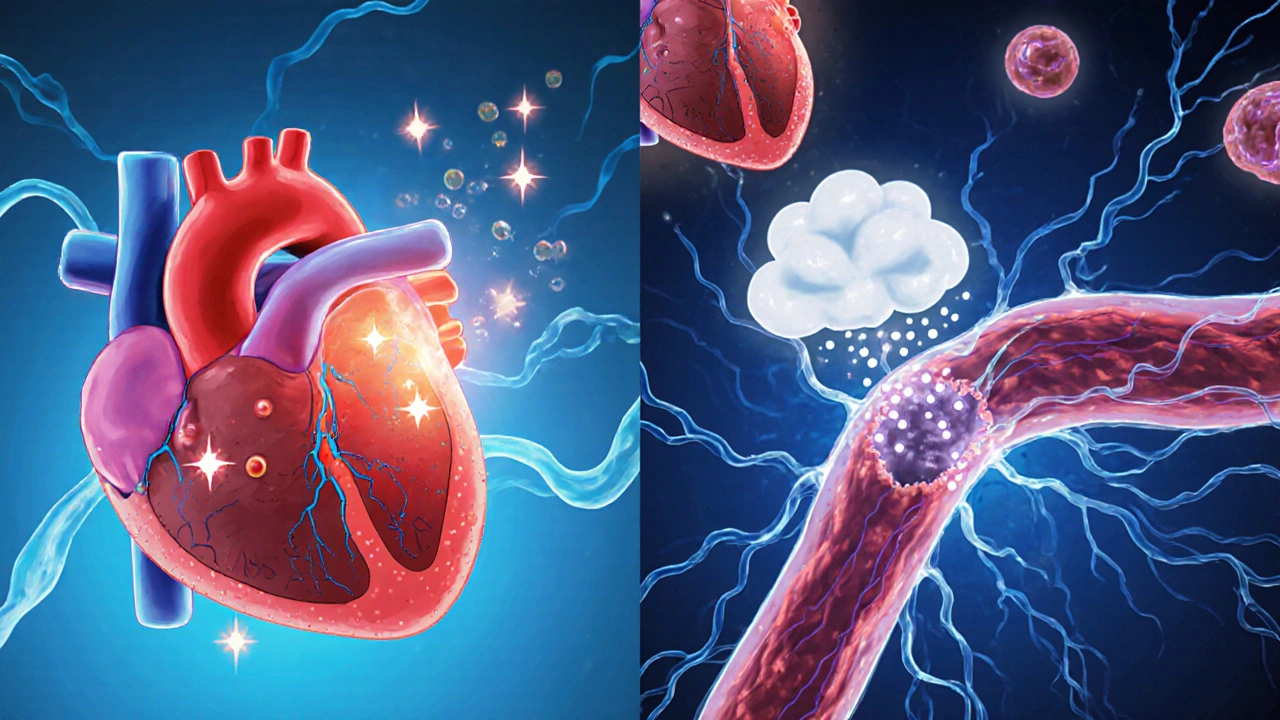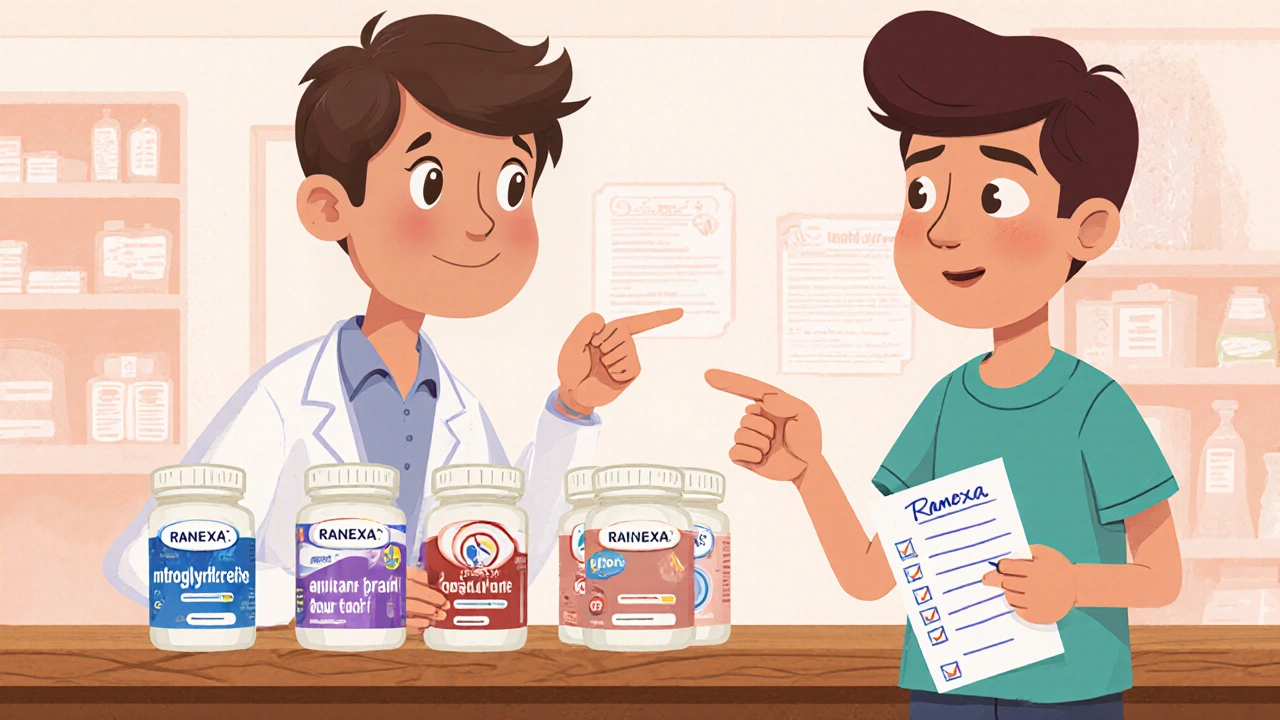Angina Treatment Decision Tool
This tool helps clinicians and patients evaluate angina treatment options based on key clinical factors. Enter patient characteristics to receive a personalized recommendation.
Patient Assessment
When it comes to chronic chest pain (angina), patients and doctors alike wrestle with a confusing menu of pills. Ranexa often appears on that menu, but how does it really stack up against the more traditional options? This guide walks through the science, safety profile, and practical considerations so you can see whether Ranexa is the right fit or if another drug makes more sense.
What is Ranexa (Ranolazine)?
Ranexa is a prescription medication whose active ingredient is ranolazine. Approved by the FDA in 2006, it is indicated for the treatment of chronic angina not adequately controlled by other therapies. Ranolazine belongs to a small class of anti‑ischemic agents that target the heart’s metabolism rather than its rhythm or blood pressure.
How Ranexa Works - The Metabolic Angle
Most angina drugs either dilate blood vessels (nitroglycerin, calcium‑channel blockers) or lower heart rate (beta‑blockers). Ranolazine takes a different route: it inhibits the late sodium current in cardiac cells, which reduces intracellular calcium overload. Less calcium means the heart muscle uses oxygen more efficiently, easing the pain without dramatically changing blood pressure or heart rate.
Major Alternatives on the Market
Below is a snapshot of the most widely used alternatives. Each has a distinct mechanism, dosing regimen, and side‑effect fingerprint.
| Drug | Mechanism | Typical Dose | Key Side Effects | Major Contra‑indications |
|---|---|---|---|---|
| Ranexa | Late sodium current inhibition | 500 mg twice daily (max 1000 mg BID) | Dizziness, constipation, QT prolongation | Severe liver disease, concomitant CYP3A4 inhibitors |
| Nitroglycerin | Vasodilation via nitric oxide release | 0.3‑0.6 mg sublingual PRN | Headache, hypotension, reflex tachycardia | Phosphodiesterase‑5 inhibitor use, severe anemia |
| Amlodipine | Calcium‑channel blockade (DHP type) | 5‑10 mg once daily | Edema, flushing, gum hyperplasia | Severe aortic stenosis, hypotension |
| Beta‑blocker | β‑adrenergic receptor blockade | Varies (e.g., metoprolol 50‑100 mg BID) | Bradycardia, fatigue, bronchospasm | Asthma, severe bradycardia, decompensated heart failure |
| Ivabradine | Selective I_f current inhibition (reduces heart rate) | 5‑10 mg twice daily | Visual phosphenes, bradycardia | Severe hypotension, sick sinus syndrome |
| Diltiazem | Non‑DHP calcium‑channel blocker | 120‑240 mg once daily (extended‑release) | constipation, AV block, edema | Second‑ or third‑degree AV block, severe heart failure |
| Isosorbide mononitrate | Long‑acting nitrate (vasodilation) | 30‑60 mg once daily | Headache, dizziness, tolerance development | Severe anemia, concomitant PDE‑5 inhibitors |

Side‑Effect Profiles: What to Watch For
Understanding tolerability is as important as efficacy. Ranexa’s most notable safety signals are QT‑interval prolongation and potential drug‑drug interactions via the CYP3A4 pathway. In practice, routine ECG monitoring is advised when starting therapy, especially for patients with baseline QTc > 450 ms.
By contrast, nitroglycerin’s headaches are predictable and often managed with dose titration. Calcium‑channel blockers like amlodipine can cause peripheral edema, which may be mistaken for heart‑failure progression. Beta‑blockers carry the classic risk of bronchospasm in patients with reactive airway disease.
Ivabradine’s visual disturbances (phosphenes) are benign but can alarm patients if not explained. Diltiazem and isosorbide mononitrate share the risk of hypotension, demanding careful blood‑pressure checks when combined with other vasodilators.
When Ranexa Beats the Rest - Ideal Clinical Scenarios
Ranexa shines in three key situations:
- Patients already on a full regimen of beta‑blockers, nitrates, and calcium‑channel blockers but still report angina. Adding Ranexa can provide incremental relief without further lowering blood pressure.
- Those who cannot tolerate the flushing or edema associated with amlodipine or diltiazem.
- Individuals with contraindications to traditional vasodilators-e.g., severe hypotension or recent myocardial infarction-where a metabolic‑focused drug is safer.
However, if a patient presents with a markedly prolonged QTc or severe liver dysfunction, alternative agents should be considered first.

Practical Checklist for Clinicians
- Confirm diagnosis of chronic stable angina and that lifestyle changes have been optimized.
- Review current medication list for CYP3A4 inhibitors (e.g., clarithromycin, ketoconazole).
- Obtain baseline ECG; note QTc interval.
- Start Ranexa at 500 mg twice daily; increase to 1000 mg BID only if tolerated.
- Re‑check ECG after 2‑4 weeks; monitor for dizziness, constipation, and any new arrhythmia.
- Educate patients about signs of serious QT prolongation (palpitations, syncope).
What the Guidelines Say (2024 ACC/AHA Update)
The 2024 ACC/AHA guideline on chronic coronary syndromes lists Ranexa as a Class IIa recommendation for patients with refractory angina despite optimal first‑line therapy (beta‑blockers, nitrates, calcium‑channel blockers). The guideline emphasizes ECG monitoring and warns against concomitant use with strong CYP3A4 inhibitors.
Bottom Line - Make the Best Choice for Your Situation
If you’ve already tried the classic trio-beta‑blocker, nitrate, and a calcium‑channel blocker-and still feel chest pressure, Ranexa offers a mechanistically different option that bypasses blood‑pressure effects. On the other hand, if you’re starting therapy from scratch, cheaper, well‑studied drugs like nitroglycerin or amlodipine may be preferable, especially when cost or insurance coverage is a factor.
Can Ranexa be used together with nitrates?
Yes. Ranexa is often added on top of standard nitrate therapy when angina persists. The combination does not intensify blood‑pressure lowering, but clinicians should still watch for additive headache or dizziness.
What monitoring is required after starting Ranexa?
A baseline ECG, followed by a repeat after 2-4 weeks, helps catch QT‑interval changes. Liver function tests are also advised because ranolazine is metabolized hepatically.
Is Ranexa safe for patients with asthma?
Ranexa does not affect bronchial smooth muscle, making it a safer choice than non‑selective beta‑blockers, which can trigger bronchospasm.
How does the cost of Ranexa compare to other angina drugs?
Ranexa is generally more expensive than generic nitrates or amlodipine. Insurance coverage varies, so checking formulary status is essential before prescribing.
Can Ranexa cause heart rhythm problems?
The main rhythm concern is QT‑interval prolongation, which can predispose to torsades de pointes in high‑risk patients. Regular ECG checks mitigate this risk.


Joy Dua
The pharmacologic narrative surrounding Ranexa is often cloaked in a veneer of novelty that masks its modest efficacy. While the metabolic approach is intellectually appealing it does not transcend the fundamental limitations of any anti‑ischemic agent. Clinicians should interrogate the cost‑benefit calculus with a rigor that rivals academic peer review. The QT prolongation risk albeit statistically low warrants a precautionary stance that many prescribers overlook. Ultimately the drug occupies a niche that is more semantic than therapeutic.
Holly Kress
The overview does a solid job laying out the mechanisms and practical checklist. I especially appreciate the clear distinction between metabolic and hemodynamic strategies. For patients wary of blood pressure drops this information can guide shared decision making. Keeping the tone neutral helps readers focus on facts rather than fear.
Chris L
I like how the guide emphasizes incremental relief for patients already on maxed‑out therapy. Adding Ranexa can be a logical next step when nitrates and beta‑blockers leave residual pain. The suggestion to monitor ECG after a few weeks is both prudent and patient‑centred. It’s encouraging to see evidence‑based recommendations that don’t shy away from realistic limitations.
renee granados
Ranexa is a pharma ploy that hides deadly heart risks.
Stephen Lenzovich
From an American perspective our therapeutic arsenal should prioritize domestically engineered solutions that respect physiological sovereignty. Ranexa, though foreign‑derived, offers a mechanistic novelty that aligns with our pursuit of cutting‑edge cardiology. Yet we must guard against overreliance on any single molecule lest we cede clinical autonomy. The guideline's Class IIa rating feels like a compromise between innovation and caution.
abidemi adekitan
Reading through the table, one can visualize a palette of options each painted with its own side‑effect brushstroke. For clinicians who cherish patient‑centered care, tailoring therapy becomes an art as much as a science. The metabolic angle of Ranexa adds a fresh hue to the otherwise red‑blue spectrum of vasodilators and beta‑blockers. Remember to assess liver function before the final brushstroke, as hepatic metabolism can alter the final masterpiece.
Barbara Ventura
Ranexa, as a metabolic anti‑ischemic agent, presents an alternative pathway, yet it is not without its own set of considerations, such as QT interval prolongation, drug‑drug interactions, and the need for periodic ECG monitoring, which some clinicians may find cumbersome, but these steps are essential for patient safety, especially in those with pre‑existing cardiac conduction abnormalities.
laura balfour
When the heart aches under the weight of chronic angina, the clinician's toolbox becomes a stage for a high‑stakes drama.
Ranexa strides onto this stage with the swagger of a metabolic rebel, daring to rewrite the script of oxygen efficiency.
Its mechanism, the inhibition of the late sodium current, sounds like a secret whispered in a cardiology back‑room.
Yet, behind the scientific fanfare lies the shadow of QT prolongation, a silent antagonist waiting in the wings.
Patients who are already juggling nitrates, beta‑blockers, and calcium‑channel blockers may find solace in this new protagonist.
The dosage titration from 500 mg twice daily to the ceiling of 1000 mg BID feels like a cautious dance, step by step.
What often goes unnoticed is the liver's role in metabolizing ranolazine, a fact that can turn a smooth performance into a stumble.
Clinicians must order baseline ECGs, then repeat them after 2‑4 weeks, lest the QT interval silently lengthen like a creeping villain.
In the grand comparison table, Ranexa shares the spotlight with nitrates that cause throbbing headaches, and amlodipine that gifts patients with troublesome edema.
The guideline's Class IIa endorsement reads like a polite applause, suggesting Ranexa when first‑line agents fail to silence the pain.
Cost, however, can be the unforgiving critic, as Ranexa's price tag often eclipses that of generic nitrates or amlodipine.
Insurance formularies may deny coverage, leaving patients to choose between financial strain and lingering chest pressure.
In practice, I have seen the drug turn a frustrated patient into a grateful one, when the ceiling of traditional therapy was already reached.
Nevertheless, never forget that each QT‑prolonging drug carries a risk of torsades de pointes, a rare but terrifying arrhythmia.
Thus, the decision to prescribe Ranexa should be weighed like a scale, balancing metabolic benefits against electrophysiologic hazards.
In the end, the story of Ranexa is neither a flawless hero nor a villainous foe, but a complex character demanding a nuanced script.
Ramesh Kumar
Hey folks, let me break down the key points in plain terms. Ranexa works by tweaking the heart’s energy use rather than just widening the vessels. This can be especially useful if you’ve already hit the max doses of nitroglycerin or beta‑blockers. Just keep an eye on the ECG and watch out for any unusual palpitations.
Alisha Cervone
The article is okay but overcomplicated. It could be shorter.
Diana Jones
Wow, that epic saga of Ranexa reads like a blockbuster screenplay, complete with villainous QT intervals and heroic dosage titration. Your dramatization, while entertaining, obscures the plain‑vanilla pharmacodynamics that most clinicians actually need to know. Let’s cut the theatrics and focus on the real‑world data-efficacy, safety, and cost‑effectiveness-so we can make evidence‑based decisions without the melodrama.
asha aurell
Ranexa’s niche is narrow; most patients will do fine on cheaper generics. Reserve it for refractory cases after thorough evaluation.